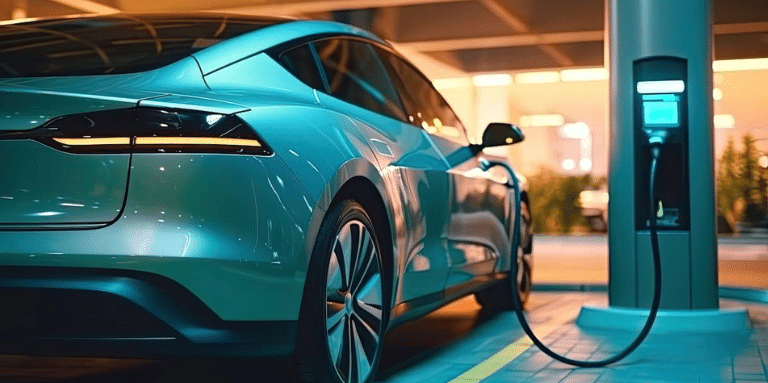Lease an electric car
Would you like to lease an electric car? Beev offers you 100% electric cars at negotiated prices, as well as recharging solutions.
Reminder: what is electric car leasing?
Government initiatives, such as the LOA (lease with purchase option) offer for electric electric cars 100 euros per month for low-income households, have helped to popularize electric car leasing. According to figures published by the French Ministry of Ecological Transition, over 50,000 French people have used the "social leasing" scheme, more than twice the initial quota of 20,000 vehicles. The aid was suspended on February 14, 2024, and will probably be renewed in 2025.
But contrary to popular belief, leasing is not just for private individuals. Companies can use it to optimize their transition to transition to sustainable mobilityregardless of the number of vehicles in their fleet.
For professionals, leasing is advantageous on a number of levels, not least because the rents are included in current expenses, in the same way as an office lease.
On paper, the principle of electric leasing is simple: it's a contract that allows you to use an electric vehicle without having to purchase it, in return for the payment of a monthly rental fee... The subscriber can choose between two options: the long-term leasing (long-term leasing) or LOA (Lease with Purchase Option). In practice, the contract includes a certain number of conditions, notably concerning early return (returning a leased car before the end of the contract), the return report or exceeding the mileage limit.
How does long-term leasing work?
Long-term leasing enables a company to build up a fleet of company vehicles, or to make one or more company cars available to its employees, without becoming the owner.
The contract is concluded for a fixed period (between 3 and 5 years). At the end of this period, the vehicle must be returned to the leasing company, in accordance with the agreed terms.
Advantages and disadvantages
The main advantage of long-term leasing for companies is that it gives them better control over their cash flow. better control over their cash flow. It is no longer necessary to invest large sums to acquire a new electric car, the value of which will be subject to a discount. Monthly payments cover the use of the vehicle and ancillary costs for the duration of the contract, freeing professionals from constraints and unforeseen events (maintenance, repairs, assistance).
From a tax point of view, leasing costs can be deducted from sales subject to SRI. Leasing an electric vehicle enables you to avoid paying the TVS (Taxe sur les véhicules des sociétés) and the malus écologiquethe amounts of which will increase significantly in 2024 for combustion-powered vehicles.
On the other hand, with leasing, the contract holder does not have the option of purchasing the vehicle. On the other hand, he or she must pay close attention to the annual mileage limitbeyond which additional charges apply.
How does LOA work?
Leasing in LOA (Location avec Option d'Achat) at first glance resembles LLDexcept that the company has the option of purchasing the vehicle at the end of the contract, by paying a residual value (trade-in value) determined in advance.
The purchase option is optional: in other words, the subscriber is free to return the vehicle to the company at the end of the contract.
Advantages and disadvantages
The LOA contract also sets a maximum maximum annual mileage. However, the terms and conditions can be relaxed if this limit is exceeded. For example, the maximum mileage can be adjusted during the term of the contract to suit actual needs. Maintenance and repair costs are not systematically included in the rent under a LOA contract. It's important to check all the clauses to avoid unpleasant surprises.
Finally, the overall acquisition cost must be taken into account. If the subscriber decides to buy the vehicle at the end of the contract, he or she will have to pay the residual value, which will be added to the lease payments already made. In this context, leasing can be more expensive than cash purchase.
The LOA contract also sets a maximum maximum annual mileage. However, the terms and conditions can be relaxed if this limit is exceeded. For example, the maximum mileage can be adjusted during the term of the contract to suit actual needs. Maintenance and repair costs are not systematically included in the rent under a LOA contract. It's important to check all the clauses to avoid unpleasant surprises.
Finally, the overall acquisition cost must be taken into account. If the subscriber decides to buy the vehicle at the end of the contract, he or she will have to pay the residual value, which will be added to the lease payments already made. In this context, leasing can be more expensive than cash purchase.
How do you return a leased electric car?
You're wondering what to do at the end of your leaseas the end of your contract approaches? If you have taken out a long-term leasing contract, you must return the vehicle to the leasing company. As we saw earlier, return is also an option with an LOA leasing contract.
This involves more than just returning the leased car on time. It requires a thorough inspection of the vehicle, both visually (general appearance) and mechanically. This must be carried out by an independent expert, commissioned by the leasing company. The purpose of this "examination" is to determine whether the returned vehicle shows any abnormal deterioration, which goes beyond legitimate wear and tear, and to invoice you for any repairs.
There are three main stages in the vehicle return inspection: inventory, mileage check and service book check.
The state of play
The inspection consists of checking the general condition of the vehicle returned at the end of the leasing contract. It is based on a visual inspection to detect any damage that does not correspond to normal use. To carry out this inspection, the expert refers to various control points These include the bodywork (dents, scratches), bumpers and moldings (trim strips), wheels and tires, windows and mirrors (any broken glass) and the passenger compartment.
Any damage detected will be assessed according to its seriousness and will be subject to additional charges, payable by the tenant.
Damage considered to be minor (e.g. minor scratches) is normal wear and tear, and does not generate additional costs.
Mileage control
Mileage must correspond to the annual ceilings specified in the leasing contract. As a result, any excess may give rise to variable charges (usually a few euro cents per kilometer driven). But the bill can quickly add up if you're not careful. For example, for an excess of 5,000 km billed at 20 eurocents per km, you'll have to pay a fee of 1,000 euros.
Refer to the rental contract to check the financial penalties incurred in the event of overrunning.
Checking maintenance
The last part of the survey concerns the mechanics. You'll need to hand over certain documents to the specialist appointed by the lessor, such as the maintenance booklet, the technical inspection reports and invoices for repairs carried out during the rental period.
Special case: how do I return a leased car before the end of the contract?
It is possible to return a leased vehicle before the end of the contractual term. To do so, you must notify the lessor (by registered mail) and obtain his agreement. Premature termination of the lease generally entails additional costs for the lessee, who must pay compensation to the leasing company.
Another (less costly) solution is to transfer the leasing contract to another lessee. Taking over a leased vehicle allows the original contract holder to withdraw from the contract without having to pay any penalties.
How to prepare for the return of a leased vehicle: our 5 tips
According to the JSL, the cost of reconditioning a leased vehicle amounts to an average of 800 euros on average (2019 figures). Good preparation before returning a leased vehicle is essential to avoid a hefty bill at the end of the contract.
Beev gives you 5 tips for returning your car with peace of mind and at no extra cost.
Be vigilant about exceeding mileage
Exceeding mileage limits can lead to substantial penalties, even though these are avoidable. It is essential to pay close attention to the annual ceilings set throughout the contract. It can be difficult to gauge the distance you'll need to cover, especially if you're on a business trip that's difficult to anticipate.
However, some leasing companies are a little more flexible, allowing you to readjust the ceilings during the term of the contract.
Respect the return date of the electric vehicle
It may seem obvious, but the first thing to do to ensure a smooth handover is to respect the contract expiry date. This requires a minimum of planning, as you need both to organize the inventory of fixtures and to think about the transition to guarantee continuity in terms of mobility and cover the needs of your employees. In this context, appointments should be made by the tenant a few weeks before the end of the contract.
Note that the lessor does not necessarily send a reminder before the expiry date.
Return the vehicle in good condition to avoid repair costs
Before you move out and hand over the keys to your landlord, you should certainly take the time to clean the apartment you're about to leave. In the same way, you should clean your electric rental car before returning it. Ideally, this task should be entrusted to a professional to ensure impeccable results.
The aim is both to make a good impression and to facilitate visual inspection of the vehicle. Take the opportunity to polish the bodywork, remove minor scratches and reinflate the tires.
Carry out maintenance and repairs as required
If it's been several months since your leased vehicle's last roadworthiness test, it may be a good idea to take it to the garage to check that it complies with the inspection checkpoints. These are listed on the return form attached to the rental contract. They include the presence of the equipment supplied with the electric vehicle (spare wheel, anti-theft nut, inflation kit, luggage cover, recharging cable, SD card, etc.) and the operation of the main mechanical components (gearbox, battery, clutch, handbrake, etc.).
A professional garage will be able to carry out minor repairs (changing windshields, replacing rims, etc.), so you won't have to pay the (often higher) fees charged by leasing agencies.
Don't forget to hand in your administrative documents
Visit verification of the vehicle's service and vehicle maintenance documents is part of the return procedure. Make sure you have all the necessary documents ready to hand over to the expert on the day. Failure to do so will delay the final handover of the vehicle. Don't forget your insurance documents and repair bills in the event of a claim during the rental period.
What's next?
At the end of the inspection, the hirer is issued with a return report (procès-verbal de restitution) and, if applicable, an invoice summarizing any charges to be paid.
Whether you are a company or an individual, Beev offers you electric car leasing and customized support. When you lease with Beev, you benefit from :
- negotiated prices thanks to winning partnerships,
- a transparent offer, with no increased first rent or deposit,
- maintenance and support included on all contracts.
Choose your electric car or or utility today! !
Discover the electric cars available from Beev





